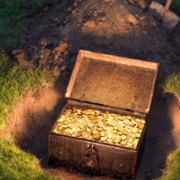Hidden Treasure and what comes next: a d’varling for Shabbat Tazria-Metzora
Last year at the start of the pandemic, my hevruta partners and I studied a text from the Piaceczyner (the rabbi of the Warsaw Ghetto) about this week’s Torah portion, Tazria-Metzora. His jumping-off point is a verse about houses contracting tzara’at — some kind of contagion — and the need to quarantine such a house for a period of time.
The commentator Rashi explains that there’s treasure hidden in the walls of the afflicted house, and when we knock down the walls, we’ll find the treasure. But the Piaceczyner is puzzled: if there’s treasure, then why does Torah tell us to wait for seven days before we can knock down the walls and find the treasures hidden therein?
His first answer makes me laugh: well, we can’t exactly know why Torah says what it says!
But then he says, if we look deeply we can recognize that in everything that happens to us, there’s a spark of God’s intention for goodness. Even if the situation we’re in is a difficult one, God intends goodness for us in it somehow.
“There may be times when we can’t access schooling for our children, or praying together in community, or going to the mikvah,” he writes. A year ago, my first thought was: that’s us, right now! Our kids are home from school. The shul building is closed. Everything is closed: to protect us from each other, from the virus we might not know we’re carrying.
The Piaceczyner said there would be treasures to be found in quarantine. I couldn’t yet imagine what they would be.
This year, these lines land entirely differently with me.
It’s still true that we still don’t have access to our former infrastructure for Jewish life. Synagogues aren’t meeting in person, Hebrew school isn’t meeting in person… And yet — look at everything we’ve learned over the last year.
Our synagogues are open, even though our buildings are not — because the synagogue isn’t the building, it’s the people and the connections among and between us, and our traditions, and our Source. We’ve learned how to pray together over Zoom, and how to make our home spaces into sacred spaces. We’ve learned how to build community and connectivity online when we can’t safely be in person.
We’ve learned how to educate our children online. Hebrew school is happening: online. Services are happening: online. We’ve learned how to share funerals, b-mitzvah celebrations, shiva minyanim, even batei din (conversions) online.
We’ve learned to find sweetness in glimpsing each others’ households — our dogs and our cats, the children and elders who share our homes — when we gather for learning or prayer. As a member of our Board said to me after Rosh Hashanah services, “Seeing people at their tables and on their couches and with their coffee cups made it feel like we were all in each others’ homes — I felt like I was getting to know people in a different way because I got to see them where they live.” Who could have imagined that, before the pandemic?
We’ve learned how to embrace video, and how to enliven our davenen with art and images. This doesn’t make up for the fact that we can’t embrace, and we can’t sing together in harmony, but it brings a different kind of hiddur mitzvah (beautifying the mitzvah) to our spiritual lives.
And we’ve learned how digital offerings can more easily include those who are immunocompromised, or hospitalized, or disabled, or homebound. We’ve learned how having our digital doors open makes our synagogues more accessible than they ever were before.
The Piaceczyner insists that even when something appears to us to be a plague, God intends goodness in it. We might just need a while to find the hidden treasure in whatever’s unfolding. As we prepare, in time, to return to our former Jewish infrastructure, I want to ensure that we do so in a way that doesn’t lose the new treasure we’ve found.
Here are some of the big questions my colleagues and I are asking:
- How can we create hybrid offerings so that as some of us feel safely able to gather in person, others can be full participants digitally?
- How can we continue to embrace the gifts of multimedia and visual art once we’re back in the building again?
- How can we welcome and include people joining us digitally, without creating a future in which no one bothers to “come to shul” because it’s easier to just stay home?
- How can we use what we’ve learned this year to help us become more accessible, more equitable, and more inclusive?
- How can we use what we’ve learned this year to help us build and sustain community across distance, whether it’s the distance between the shul and a hospital bed, or the distance between here and someplace further away?
- How might our sense of community expand and adapt if people keep participating in services and learning and festival observances online — if you don’t have to be in Northern Berkshire to become a part of CBI?
- And how can we honor the treasures of this pandemic learning while also honoring the very real losses of this incredibly difficult year?
We don’t know the answers yet: we’re figuring them out as we go. The crisis of COVID-19 offers us an opportunity to dream big and think creatively about what it means to do Jewish together now. I hope you’ll grapple with these questions too, and let me know your answers.
This is the d’varling that Rabbi Rachel offered at Kabbalat Shabbat services (cross-posted to Velveteen Rabbi.)






